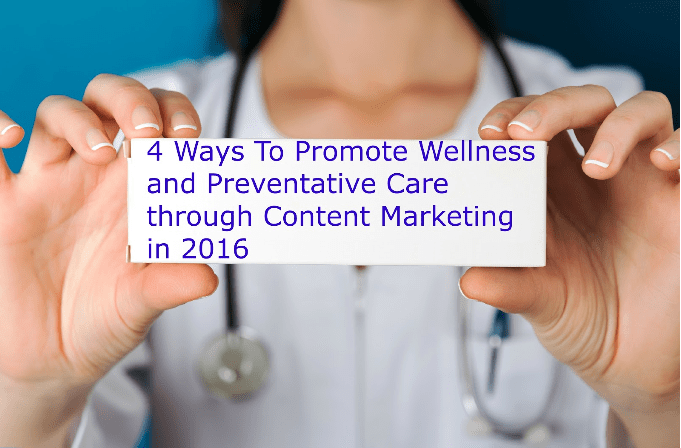While healthcare marketing managers undertake a wide range of roles, one thing they are responsible for is their organization’s brand awareness. These marketers must take into consideration their company’s vision and deliver that message through the appropriate means to ensure it is heard by those they want to target. Content marketing is vital for healthcare organizations, as pointed out by Google, because healthcare consumers are definitely looking for general information regarding healthcare.

For healthcare organizations to be profitable, identifying potential markets is vital, such as the implementation of wellness and preventative care programs for their patients and with good reason. With 133 million Americans having at least one preventable chronic condition, US Corporate Wellness reports that these diseases account for 1.3 trillion spent a year, adding up to 1.1 trillion in lost productivity and 2.77 billion a year spent on treatments. They also indicate that for every $1 invested in wellness and preventative care programs, there is the potential to save $3-$6.
Healthcare marketers must establish their organization as leaders in healthcare, and the implementation of wellness and preventative care programs do just that. By promoting programs to help educate and overcome unhealthy lifestyles, such as obesity and smoking, healthcare institutions can provide their customer base with the tools needed to help their patients achieve healthier behaviors. The key in successful wellness and preventative care programs is how to get the word out so people will act. Here are four ways that healthcare marketing managers can effectively call attention to preventative care programs so that active participation is accomplished.
- Podcasts: With ⅓ of Americans having listened to a podcast, healthcare organizations can provide their insight into wellness programs for the consumer on the go. Podcasts allow listeners the ability to multitask. For example, while on a road trip, consumers can listen to doctors share ways to incorporate more exercise into their daily routine, or they can listen to a smoking cessation seminar. The key to podcasting efficiently is to tell a story by making the subjects interesting and relevant, not lecture-like, which is sure to bore listeners. Keep podcasts 20-30 minutes, and promote via social media to increase engagement and encourage users to listen to your content on the go while commuting to work or working out.
- Videos: Video is a great way for healthcare businesses to humanize their brand, educate patients, and provide a virtual peek into the facilities. YouTube has over 100 billion users and is the most popular in social media platforms for healthcare communications, over Facebook, LinkedIn, and Twitter. In healthcare, video matters.

Think about how you can leverage the power of video to highlight your healthcare business. If you have a new surgery center, highlight its state-of-the-art features. Do you have a new doctor on staff? Why not conduct an interview to introduce him or her to the community? Want to increase bariatric surgery bookings? Interview patients who have had the surgery and the positive effect it has had on their life. There are stories everywhere that can be recorded and shared with the world; a marketer just needs to be cognizant of all opportunities that can be translated into video.
- Infographics: Compelling and attractive, infographics are more than just fancy pictures. They can actually increase brand awareness, establish a brand as an expert in the healthcare industry, and increase website traffic. Complex issues that require data to be explained are presented more easily in an infographic, especially since 90 percent of information coming to the brain is visual. Are you wanting to implement a new heart disease prevention program at your hospital? Then highlight the statistics surrounding the positive effects of a heart-healthy way of living. Consumers are able to scan easily, absorbing the information you want to convey quickly and concisely. Positive SEO results can be accomplished with infographics since they are linked back to your site, increasing traffic to your site resulting in increased visibility in the search engines.
- Blogging: With its ability to educate, engage, and connect with particular audiences, blogging is a powerful tool for healthcare marketers wanting to raise awareness for wellness and preventative programs. For example, if your healthcare organization would like to address the obesity epidemic and wants to execute weight loss programs, author blogs such as “How to Jumpstart Your Weight Loss Efforts the Right Way,” and optimize the blog with weight loss related keywords by generating anchor links back to your weight loss treatment landing page. This will allow for users to dive deeper into your website and find the information they are looking for. Also, don’t forget to cover trending topics within your particular wellness program so that your content will be found.
With so many content marketing tools out there for healthcare marketing managers, it is important to choose the correct ones and to execute them the right way in regards to increasing awareness about the preventative and wellness programs offered. But it really always comes back down to content marketing and understanding how it works and how it is essential to any online campaign. If you need help with your healthcare digital marketing efforts, please contact On Target Digital Marketing today at 866-998-6886. We have the expertise and experience to ensure your campaign is a successful one.
Thank you for reading,
Jennifer

